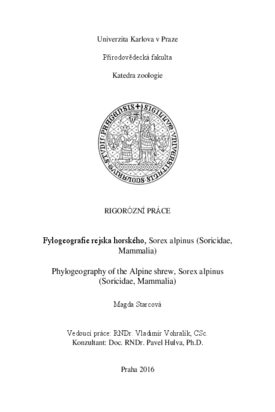Fylogeografie rejska horského, Sorex alpinus (Soricidae, Mammalia)
Phylogeography of the Alpine shrew, Sorex alpinus (Soricidae, Mammalia)
rigorózní práce (OBHÁJENO)

Zobrazit/
Trvalý odkaz
http://hdl.handle.net/20.500.11956/75372Identifikátory
SIS: 180542
Katalog UK: 990021097880106986
Kolekce
- Kvalifikační práce [21483]
Autor
Oponent práce
Horáček, Ivan
Fakulta / součást
Přírodovědecká fakulta
Obor
Zoologie
Katedra / ústav / klinika
Katedra zoologie
Datum obhajoby
17. 10. 2016
Nakladatel
Univerzita Karlova, Přírodovědecká fakultaJazyk
Čeština
Známka
Prospěl
Rejsek horský (Sorex alpinus Schinz, 1837) je drobný zástupce čeledi Soricidae, který se vyskytuje v horských lesích střední a jihovýchodní Evropy. Jeho ostrůvkovitý areál rozšíření zahrnuje Alpy, severozápadní pohoří Balkánu, Karpaty a izolované oblasti v Německu, České republice a Polsku. Tento disjunktní areál rozšíření rejska horského je považován za následek areálové dynamiky druhu spojené s pleistocenními oscilacemi klimatu. Cílem této práce bylo prozkoumat fylogeografickou strukturu rejska horského v oblasti střední a jižní Evropy. K odhalení genetické struktury populací rejska horského byla použita sekvence hypervariabilní domény mitochondriální kontrolní oblasti. Bylo zpracováno 51 vzorků z 18 lokalit zahrnujících většinu areálu rozšíření druhu. Výsledný dataset sekvencí byl analyzován pomocí metod populační a landscape genetiky. Výsledky ukázaly mělkou mitochondriální genealogii s diferenciací mezi haploskupinami. To společně s demografickou analýzou naznačuje populační nárůst podporující hypotézu o expanzi rejska horského během ledových dob. Po skončení poslední doby ledové následovala fragmentace areálu rejska a jeho ústup do vyšších nadmořských výšek a vytvoření reliktních populací. Klíčová slova: rejsci, d-loop, landscape genetika, genetická struktura
The Alpine shrew (Sorex alpinus Schinz, 1837) is a small member of family Soricidae, which is found in mountain forests of central and south Europe. Its patchy range includes the Alps, the NW Balkans, the Carpathians, and some isolated mountain areas in Germany, Czech Republic and Poland. The disjunct range of Alpine shrew presumably results from range dynamics of the species connected with Pleistocene climate oscillation. The aim of this study was to investigate phylogeographical structure of the Alpine shrew in the central and SE European mountain systems. To examine genetic structure of Alpine shrew populations the hypervariable domain of the mitochondrial control region was used. We processed 51 samples from 18 localities, covering the majority of the distributional area of the species. Final sequence dataset was analyzed using population and landscape genetic approaches. Results revealed shallow mitochondrial genealogy with differentiation among haplogroups. This pattern, together with demographic analyses suggest population expansion, corroborated with the hypothesis that during glacial periods the Alpine shrew expanded. End of the last ice period was followed by fragmentation of the species range and its retreat to higher elevations and formation of relict populations. Key words: shrews,...
